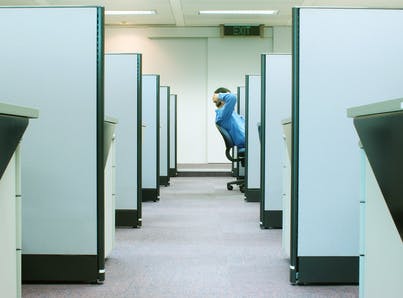Following the lead of Google, Yahoo, and eBay, the open-office plan has spread like a virus from Silicon Valley startups to city governments. And as the open-office trend has grown, so has the backlash against it.
In fact, a New York Times article recently criticized open office plans’ encroachment upon workers’ privacy. The piece highlighted an open layout’s ability to expose, for example, a colleague’s colonoscopy appointment and identified the need for “refuge rooms” to seek solace from the noise.
A growing body of research has found that certain aspects of open floor plans may lead to increased employee stress and absenteeism, lower productivity, and decreased satisfaction. Responses have morphed from civil arguments that it’s not an ideal option to bursts of outrage that any company would even consider it.
Is an open office a good fit for your company?
But when implemented for the right reasons (and with the right concessions), an open office isn’t the destructive force productivity gurus are making it out to be.
Open offices do pose unique challenges, such as noise, distractions, and a lack of privacy. But companies like Google take design seriously, and their approach isn’t wrong.
The open-office strategy works for Google because it fits the brand, its strategy, and its emphasis on collaboration. Google has been intentional about creating an environment that encourages “casual collisions” in high-traffic areas while simultaneously allowing employees to carve out private workspaces as needed. The same is true of other successful companies like Pixar.
The problem is that many articles — like this one in The Washington Post claiming Google has led us all astray — don’t consider whether an open office is the best fit for a particular company. The author slams the concept without considering the underlying reasons why it didn’t work for her organization.
Rather than make decisions based on bad individual experiences, HR managers should recommend office layouts based on their own companies’ needs and goals.
I spoke with Maya Razon, a respected organizational consultant in the Bay Area, to get her thoughts on the topic. We discussed three main things HR managers must understand:
1. One layout won’t meet everyone’s needs
Your team isn’t one-dimensional. It’s made up of individuals with different preferences and working styles. Razon said that no matter what your corporate culture, industry, or company demographics are, human preferences are diverse.
Some workers will prefer privacy, and some will prefer shared space. There are also practical considerations. I’ve seen employees struggle with a lack of privacy when handling sensitive information or having difficult conversations about employee performance, restructuring, or non-public business events.
Flexibility is the key. Rather than choosing between being entirely open or assigning everyone a cubicle, you could design an open office that includes private workspaces and meeting areas. A variety of work areas will allow employees to escape the open bullpen for private conversations, work in small groups, and do their jobs however they’re most effective.
2. Your physical environment should drive strategy
Whichever office plan you decide on, make sure you choose it for the right reasons. Picking an open office plan to cut costs or follow a trend won’t deliver the benefits you’re hoping for.
“Moving to an open-space concept cannot be a fad,” says Razon. “It should be used to address real-world problems and linked to solutions.”
She suggests using office design as a tactic to achieve a specific result. Ask yourself whether your physical space aligns with and reinforces your company’s values. Will it support the work you need to do on a daily basis? How will it affect your team’s productivity? Does it reinforce your organizational structure? Have you made concessions to respect confidentiality?
Just as cubicles won’t turn your employees into mindless cogs overnight, an open floor plan filled with beautiful reclaimed wooden tables won’t transform your company into a hip, creative place where everybody feels comfortable sharing their ideas. Your environment is simply a tool that supports the behaviors you want to encourage.
If you can’t pinpoint how an open office will promote the behaviors you need to reach specific goals, it’s OK to determine it’s not a good fit.
3. No one likes change
If you decide that an open office would help your company, be prepared for some resistance. Sitting people around one big table does more than distract them — it forces them to relinquish control over their personal workspace.
According to Razon, moving to an open-work environment should be handled just like any other major company shift.
“It takes time for employees to understand and digest the new world … whatever that may be,” she says. “Changing a way of working takes an intentional, thoughtful approach. Creating opportunities for input before the change, fostering dialogue, and establishing new norms and expectations are key.”
You can’t change someone’s personality or preferences around work, so there’s no use trying. What you can do is help employees understand the rules and etiquette around space. Setting clear expectations will help make people comfortable and let them know when to opt out if the change won’t work for them.
What do you want to achieve?
Physical settings play a big role in how people work. Don’t just hop on the bandwagon or switch to an open floor plan to cram more bodies in.
You really need to think about what you’re hoping to achieve — and decide which layout will help you reach those goals.
